万圣节的由来50字英文,万圣节的由来英文简短
万圣节中英文介绍
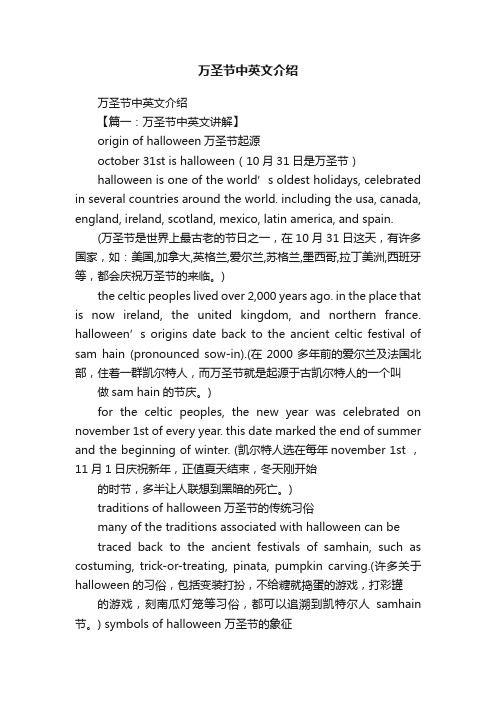
万圣节中英文介绍万圣节中英文介绍【篇一:万圣节中英文讲解】origin of halloween万圣节起源october 31st is halloween(10月31日是万圣节)halloween is one of the world’s oldest holidays, celebrated in several countries around the world. including the usa, canada, england, ireland, scotland, mexico, latin america, and spain.(万圣节是世界上最古老的节日之一,在10月31日这天,有许多国家,如:美国,加拿大,英格兰,爱尔兰,苏格兰,墨西哥,拉丁美洲,西班牙等,都会庆祝万圣节的来临。
)the celtic peoples lived over 2,000 years ago. in the place that is now ireland, the united kingdom, and northern france. halloween’s origins date back to the ancient celtic festival of sam hain (pronounced sow-in).(在2000多年前的爱尔兰及法国北部,住着一群凯尔特人,而万圣节就是起源于古凯尔特人的一个叫做sam hain的节庆。
)for the celtic peoples, the new year was celebrated on november 1st of every year. this date marked the end of summer and the beginning of winter. (凯尔特人选在每年november 1st ,11月1日庆祝新年,正值夏天结束,冬天刚开始的时节,多半让人联想到黑暗的死亡。
万圣节的由来英语加翻译_万圣节的来历中英文对照
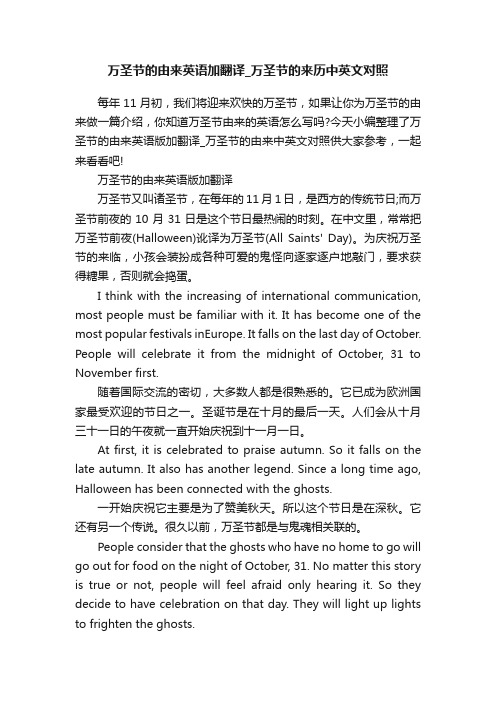
万圣节的由来英语加翻译_万圣节的来历中英文对照每年11月初,我们将迎来欢快的万圣节,如果让你为万圣节的由来做一篇介绍,你知道万圣节由来的英语怎么写吗?今天小编整理了万圣节的由来英语版加翻译_万圣节的由来中英文对照供大家参考,一起来看看吧!万圣节的由来英语版加翻译万圣节又叫诸圣节,在每年的11月1日,是西方的传统节日;而万圣节前夜的10月31日是这个节日最热闹的时刻。
在中文里,常常把万圣节前夜(Halloween)讹译为万圣节(All Saints' Day)。
为庆祝万圣节的来临,小孩会装扮成各种可爱的鬼怪向逐家逐户地敲门,要求获得糖果,否则就会捣蛋。
I think with the increasing of international communication, most people must be familiar with it. It has become one of the most popular festivals inEurope. It falls on the last day of October. People will celebrate it from the midnight of October, 31 to November first.随着国际交流的密切,大多数人都是很熟悉的。
它已成为欧洲国家最受欢迎的节日之一。
圣诞节是在十月的最后一天。
人们会从十月三十一日的午夜就一直开始庆祝到十一月一日。
At first, it is celebrated to praise autumn. So it falls on the late autumn. It also has another legend. Since a long time ago, Halloween has been connected with the ghosts.一开始庆祝它主要是为了赞美秋天。
万圣节起源英文介绍

万圣节起源英文介绍万圣节起源英文介绍大家知道怎么万圣节的起源是什么吗?会用英语介绍万圣节吗?下面是店铺跟大家分享的万圣节的起源介绍,希望大家喜欢!【万圣节介绍】In October ist Hochsaison für Hexen, Gespenster, Geister und alle, die sich gerne Gruseln, denn am 31. Oktober ist Halloween.十月是女巫,幽灵,鬼魂和一切让人不寒而栗的东西出现的旺季,因为10月31日是万圣节。
Ursprünglich, vor Hunderten von Jahren, war Halloween ein Herbstfest der Druiden im alten England. Es sei die einzige Nacht des Jahres, so glaubten die Menschen damals, in der Hexen und Geister leibhaftig auf der Erde herumspukten.起初在几百年前,万圣节在古英格兰对巫师们来说是秋天节。
那时人们认为,这一天晚上是一年当中唯一一个女巫和鬼魂真的来到人间到处作祟的夜晚。
Fast jedes Kind weiß, dass Halloween etwas mit Gespenstern, Hexen und Verkleiden zu tun hat, aber kaum jemand hat eine Ahnung, was es mit dem Fest ‚Halloween’ nun wirklich auf sich hat.几乎每个孩子都知道,万圣节与幽灵,女巫和化装有关,但是几乎没有一个人知道,万圣节这个节日究竟因何而来。
Schon vor über 2000 Jahren feierten die Kelten im alten England (heute sagen wir Großbritannien dazu) zum Ende des Sommers ein großes Fest –damals hieß es noch‚Samhain’.Der 31. Oktober war bei den Kelten der letzte Tag des Jahres, denn sie hatten einen anderen Kalender als wir heute. Der Sommer wurde mit großen Feuern verabschiedet und gleichzeitig der Winter begrüßt.Die Menschen bedankten sich bei ihrem Sonnengott (mit Namen ‚Samhain’) für die Ernte, die sie in der warmen Jahreszeit eingebracht hatten und gedachten an diesem Tag auch der Seelen der Verstorbenen. Der Sonnengott wurde nun, zu Beginn der dunklen Winterzeit von dem keltischen Gott der Toten, abge löst.早在两千多年前,古英格兰(今天的大不列颠)的克勒特人在夏季结束时会进行一场盛大的节日庆祝——那时这个节日叫做“萨温节”。
万圣节的由来英文版简短带中文翻译
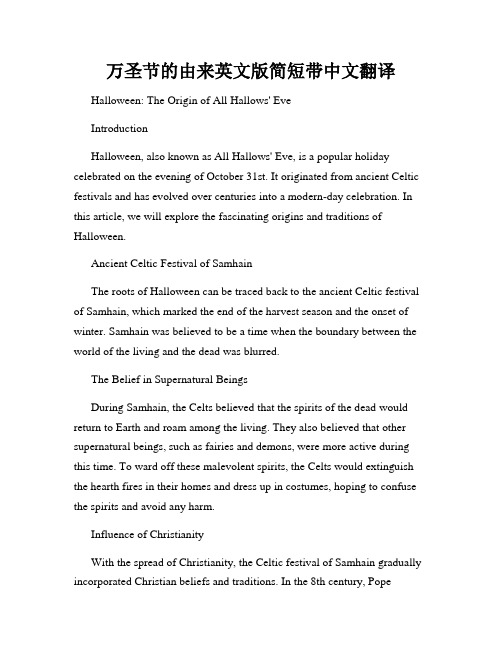
万圣节的由来英文版简短带中文翻译Halloween: The Origin of All Hallows' EveIntroductionHalloween, also known as All Hallows' Eve, is a popular holiday celebrated on the evening of October 31st. It originated from ancient Celtic festivals and has evolved over centuries into a modern-day celebration. In this article, we will explore the fascinating origins and traditions of Halloween.Ancient Celtic Festival of SamhainThe roots of Halloween can be traced back to the ancient Celtic festival of Samhain, which marked the end of the harvest season and the onset of winter. Samhain was believed to be a time when the boundary between the world of the living and the dead was blurred.The Belief in Supernatural BeingsDuring Samhain, the Celts believed that the spirits of the dead would return to Earth and roam among the living. They also believed that other supernatural beings, such as fairies and demons, were more active during this time. To ward off these malevolent spirits, the Celts would extinguish the hearth fires in their homes and dress up in costumes, hoping to confuse the spirits and avoid any harm.Influence of ChristianityWith the spread of Christianity, the Celtic festival of Samhain gradually incorporated Christian beliefs and traditions. In the 8th century, PopeGregory III designated November 1st as All Saints' Day, a day to honor saints and martyrs. The evening before, which had been Samhain, became known as All Hallows' Eve, eventually evolving into Halloween.Trick-or-Treating TraditionThe tradition of trick-or-treating can be traced back to the medieval Christian practice of "souling." On All Souls' Day (November 2nd), poor Christians would go door-to-door, offering prayers for the souls of the deceased in exchange for food. This practice later evolved into children going from house to house, collecting sweets and treats.Jack-o'-LanternsThe tradition of carving pumpkins into Jack-o'-lanterns originated from an Irish folklore. The story goes that a man named Jack, who was known for his trickery, managed to trick the devil twice. As a punishment, he was denied entry to heaven and hell. Jack was left to wander the Earth with only a lantern made from a turnip and a burning coal inside it, lighting his way. When Irish immigrants brought this story to the United States, they began using pumpkins instead of turnips to create Jack-o'-lanterns.Modern Halloween CelebrationsToday, Halloween is celebrated in various ways across the world. In addition to trick-or-treating, costume parties, haunted houses, and pumpkin carving have become popular traditions. Many people enjoy dressing up as their favorite characters or creatures, ranging from superheroes to ghosts and witches. It has become a festive occasion for people of all ages to embrace their creativity and have fun.ConclusionFrom its ancient Celtic origins to its evolution through Christian influence, Halloween has become a beloved holiday that brings joy and excitement to people around the world. Whether it's the spooky decorations, the thrill of dressing up, or the joy of sharing treats, Halloween has transcended its initial traditions and embraced by diverse cultures.。
万圣节的由来英文版简短带中文翻译

万圣节的由来英文版简短带中文翻译Halloween, also known as All Hallows' Eve, is celebrated on the night of October 31st. Its roots can be traced back to ancient Celtic festivals, particularly the Gaelic festival of Samhain. It was originally celebrated in Ireland, Scotland, and the Isle of Man.Halloween has its origins in the ancient Celtic festival of Samhain, which was celebrated on the night of October 31st. The Celts believed that on this night, the veil between the worlds of the living and the dead was thinnest, and that the spirits of the dead could return to the world of the living. They would light bonfires and wear costumes to ward off evil spirits.When the Romans conquered the Celts, they added their own festivals to the mix. The Roman festival of Feralia, which honored the dead, was held in late October. The Romans also celebrated Pomona, the goddess of fruit and trees, around the same time. Her symbol was the apple, which explains why apple bobbing is a popular Halloween activity.Even Christianity has played a role in the evolution of Halloween. All Saints' Day was originally celebrated on May 13th, but in the 8th century, Pope Gregory III declared that All Saints'Day should be celebrated on November 1st. The night before, October 31st, became known as All Hallows' Eve, or Halloween.In the United States, Halloween became popular in the early 1900s. It was a time for communities to come together and celebrate with parades and parties. Trick-or-treating, or going door-to-door to receive candy, became a popular activity in the 1930s.Today, Halloween is celebrated in many countries around the world, though traditions may vary. In some places, it is still a time to remember the dead and honor departed loved ones; in others, it is a night of spooky fun and dressing up in costumes.Halloween is a fascinating holiday with a complex history that has evolved over time with the addition of various cultural traditions. Whether you celebrate Halloween for its spooky thrills or as a way to honor the dead, the holiday remains popular and beloved throughout the world.萨温节(Samhain),是古代凯尔特人庆祝的一个节日(万圣节的起源)。
关于万圣节的由来英文
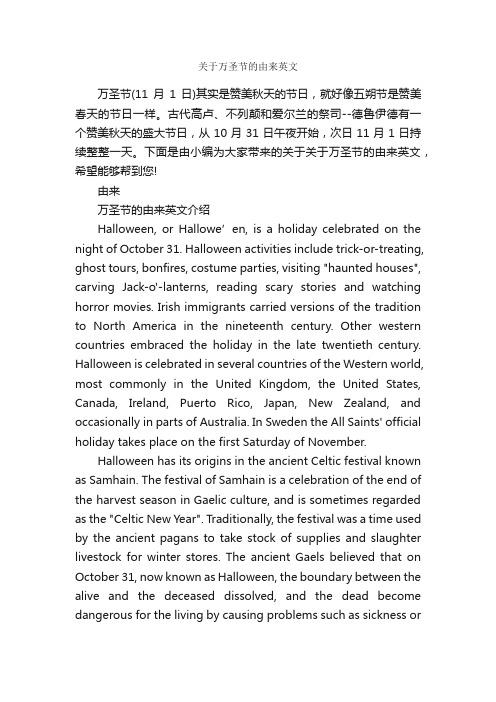
关于万圣节的由来英文万圣节(11月1日)其实是赞美秋天的节日,就好像五朔节是赞美春天的节日一样。
古代高卢、不列颠和爱尔兰的祭司--德鲁伊德有一个赞美秋天的盛大节日,从10月31日午夜开始,次日11月1日持续整整一天。
下面是由小编为大家带来的关于关于万圣节的由来英文,希望能够帮到您!由来万圣节的由来英文介绍Halloween, or Hallowe’en, is a holiday celebrated on the night of October 31. Halloween activities include trick-or-treating, ghost tours, bonfires, costume parties, visiting "haunted houses", carving Jack-o'-lanterns, reading scary stories and watching horror movies. Irish immigrants carried versions of the tradition to North America in the nineteenth century. Other western countries embraced the holiday in the late twentieth century. Halloween is celebrated in several countries of the Western world, most commonly in the United Kingdom, the United States, Canada, Ireland, Puerto Rico, Japan, New Zealand, and occasionally in parts of Australia. In Sweden the All Saints' official holiday takes place on the first Saturday of November.Halloween has its origins in the ancient Celtic festival known as Samhain. The festival of Samhain is a celebration of the end of the harvest season in Gaelic culture, and is sometimes regarded as the "Celtic New Year". Traditionally, the festival was a time used by the ancient pagans to take stock of supplies and slaughter livestock for winter stores. The ancient Gaels believed that on October 31, now known as Halloween, the boundary between the alive and the deceased dissolved, and the dead become dangerous for the living by causing problems such as sickness ordamaged crops. The festivals would frequently involve bonfires, into which bones of slaughtered livestock were thrown. Costumes and masks were also worn at the festivals in an attempt to mimic the evil spirits or placate them.万圣节,是国际性节日庆祝10月31日。
万圣节的由来简短英语小作文(带翻译)精选5篇

万圣节的由来简短英语小作文(带翻译)精选5篇Halloween 这个字的意思,是从 All Hallows Eve (Hallows 指圣人)而来,即指十一月一日诸圣节的前一天晚上。
小编整理了万圣节的由来简短英语小作文精选5篇,希望能帮助到您。
万圣节的由来简短英语小作文Halloween is the one of the oldest holidays still celebrated today. It's one of the most popular holidays, second only to Christmas. While millions of people celebrate Halloween without knowing its origins and myths, the history and facts of Halloween make the holiday more fascinating. Some people view Halloween as a time for fun, putting on costumes, trick-or-treating, and having theme parties. Others view it as a time of superstitions, ghosts, goblins and evil spirits that should be avoided at all costs. As the Christian debate goes on, celebrating Halloween is a preference that is not always viewed as participating in an evil holiday. Halloween is often celebrated with no reference to pagan rituals or the occult.万圣节是当今人们仍在庆祝的最古老的节日之一,它也是最受欢迎的节日之一,仅次于圣诞节。
万圣节的由来「中英文版」
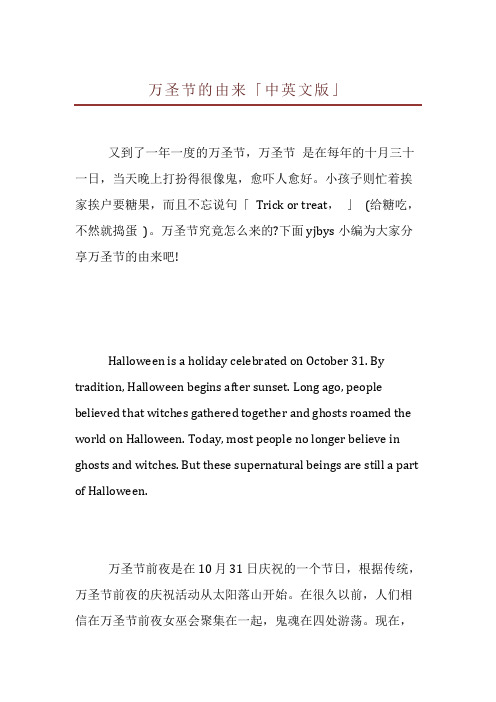
万圣节的由来「中英文版」又到了一年一度的万圣节,万圣节是在每年的十月三十一日,当天晚上打扮得很像鬼,愈吓人愈好。
小孩子则忙着挨家挨户要糖果,而且不忘说句「Trick or treat,」(给糖吃,不然就捣蛋)。
万圣节究竟怎么来的?下面yjbys小编为大家分享万圣节的由来吧!Halloween is a holiday celebrated on October 31. By tradition, Halloween begins after sunset. Long ago, people believed that witches gathered together and ghosts roamed the world on Halloween. Today, most people no longer believe in ghosts and witches. But these supernatural beings are still a part of Halloween.万圣节前夜是在10月31日庆祝的一个节日,根据传统,万圣节前夜的庆祝活动从太阳落山开始。
在很久以前,人们相信在万圣节前夜女巫会聚集在一起,鬼魂在四处游荡。
现在,大多数人们不再相信有鬼魂和女巫的存在了,但是他们仍然把这些作为万圣节前夜的一部分。
Some Catholic believers will be alive with ultra virtue canonized in recognition of those believers, side by side for the model followed by other believers. But because believers with extraordinary virtue in fact a lot of it is just unknown, for those who did not fail no smell, the church is not to be established as a saint, it seems a bit unfair, so the All Saints’ Day, Memorial All saints canonized by the church and should be canonized, but not the canonization of believers.天主教会将一些生前具有超高德性的信徒封为圣人,以表彰那些信徒,并立为其他信徒所遵循的模范。
万圣节来源英文介绍

万圣节来源英文介绍万圣节来源英文介绍尽管关于万圣节的起源和旧俗有很多不同的看法,但有一些是被所有人接受的。
不同文化看待万圣节总是有点不同,但是传统的万圣节做的`事情都是一样的。
下面店铺准备了万圣节的来源英语介绍,大家一起来看一下吧!【万圣节来源】It’s October the 31st, andacross Britain and the USA, thousands of children are dressing upas monsters, ghosts and witches and going to their neighbours’houses to ask for sweets or to play tricks on them if they refuse.Many houses have lanterns made from pumpkins in their windows.These lanterns have frightening faces cut into them.What is thereason for all of this? It’s Halloween!To an outsider, this mayseem a strange festival, but it is a very popular one and animportant part of the culture in Britain and the USA. But how didit start? The holiday once had a religious significance.Novemberthe 1st is All Saint’s Day, and October the 31st was believed to bea day when all the spirits came back to the world of the living.Inmodern times, this has changed to be a day when children dress upas monsters, ghosts and witches. Once they are dressed up childrengo to their neighbours’ houses.They knock on the door and shout‘Trick or treat!’ Good neighbours, of course, give ‘treats’.Theseare usually sweets or chocolates. Bad neighbours, however, may givenothing.If so, t hen the children play a ‘trick’ on them. This maybea simple practical joke.However, naughty children may dosomething worse, like throwing rubbish in the neighbour’s garden.Nowadays, of course, most neighbours always give a treat.Afterall, it’s fun for t he children. Another tradition is to makelanterns from pumpkins. First, the inside of the pumpkin isremoved. Then, a face is cut into the pumpkin, traditionally asmiling, devil face.Finally a candle is placed inside, and thelantern is put at the front of the house to keep evil spirits away.There are many traditional games on Halloween, but the most commonis ‘apple-bobbing’.It’s simple to play. Several apples are putfloating in water. Children then have their hands tied behind theirbacks.They then have to try to pick the apples out of the waterusing only their mouths. Of course, people get very wet and it isvery funny to watch.Vocabulary:dressing up:乔装打扮;穿上盛装monsters:怪物;妖怪ghosts:鬼;幽灵witches 巫师neighbour:邻居sweets:糖果tricks:恶作剧;诡计lanterns:灯笼outsider:外人;局外人treat:招待;请客practical joke:恶作剧evil:邪恶的下载全文。
万圣节的由来英文版简短中文翻译

万圣节的由来英文版简短中文翻译The Origin of HalloweenHalloween, also known as All Hallows' Eve, is a festival celebrated on October 31st each year. It originated from an ancient Celtic festival called Samhain, which marked the end of the harvest season and the beginning of winter. Now let's delve into the fascinating history of Halloween and discover how it has evolved into the holiday we know today.Samhain, which means "summer's end" in Gaelic, was a significant event for the ancient Celts. They believed that on the night of October 31st, the boundary between the living and the dead blurred, allowing spirits to roam freely on Earth. The Celts lit bonfires and wore costumes made of animal heads and skins to ward off these roaming spirits. Additionally, they offered food and sacrifices to placate the dead.With the expansion of the Roman Empire, Celtic territories came under Roman rule, leading to cultural exchange and the incorporation of Roman festivals into Celtic traditions. One such festival was Feralia, a day dedicated to commemorating the passing of the dead. The Romans also celebrated Pomona, the goddess of fruit and trees, around the same time, with symbolisms of fertility and abundance.In the 8th century, Pope Gregory III designated November 1st as All Saints' Day, later known as All Hallows' Day, to honor all saints and martyrs who did not have their own designated feast days. The eve of this holy day, October 31st, became known as All Hallows' Eve, eventually becoming "Halloween."When Christianity spread through Celtic lands, it incorporated some of the Samhain traditions into the Christian festivities. All Hallows' Eve became a time for prayer and reflection, when people believed they could communicate with the souls of the departed. It was believed that souls trapped in purgatory could be released through prayers, a practice known as "souling."As time went on, Halloween continued to evolve. In Europe during the Middle Ages, All Hallows' Eve became a time for community gatherings, storytelling, and games. People dressed up as saints, angels, and demons, mimicking the supernatural beings they believed were present on that night.The tradition of "guising" emerged during the 16th century in Scotland and Ireland. Children and young adults disguised themselves and went door-to-door, reciting verses or songs in exchange for food or money. This practice bears similarities to modern-day trick-or-treating.Irish and Scottish immigrants brought Halloween customs to North America in the 19th century. Due to strong beliefs in ghosts and various supernatural beings, Halloween traditions took hold and developed further. The focus shifted from religious aspects to community festivities, including parties, games, and parades. Jack-o'-lanterns, originally carved from turnips and later pumpkins, became popular decorations.In the 20th century, Halloween became more commercialized with the mass production of costumes, decorations, and candy. Today, it is predominantly celebrated as a fun and spooky holiday, with people of all ages participating in costume parties, haunted houses, and watching horror movies.In conclusion, Halloween's origins can be traced back to the Celtic festival of Samhain. Over time, it absorbed influences from various cultures and transformed into the holiday we know today. While its customs and significance may have changed, Halloween remains a beloved occasion that brings people together to celebrate in their own unique ways.万圣节的由来万圣节(Halloween),也称为诸圣节前夜(All Hallows' Eve),是每年的10月31日庆祝的一个节日。
万圣节的由来英文版简短带中文翻译

万圣节的由来英文版简短带中文翻译现在西方很多国家都在万圣节前夜也就是10月31号这一天晚上,举行庆典或者和朋友聚会。
下面是小编为大家带来万圣节的由来英文版简短带中文翻译的,希望大家能够喜欢!万圣节的由来英文版简短带中文翻译The Halloween celebrationcomes from All Hallows Day or All Saints Day, the 1st of November. This wasoriginally a pagan festival of the dead, but later became a holiday to honorChristian saints.万圣节的庆祝活动来源于每年11月1日的All Hallows Day 或All Saints Day。
它原先是异教徒们纪念死者的节日,但是逐渐演变成一个纪念基督圣者的节日。
The name Halloween comesfrom a contraction of All Hallows Eve (Evening), the day before All HallowsDay. On this night it was believed that the spirits of the dead would try tocome back to life!Halloween这个词来自于All Hallows Eve(夜晚),All Hallows Eve是All Hallows Day前一天的缩写。
人们认为在当天晚上,亡者的灵魂会重新复活!Dressing up in costumesis one of the most popular Halloween customs, especially among children. Accordingto tradition, people would dress up in costumes (wear special clothing, masksor disguises) to frighten the spirits away.Dressing up in costumes是最受欢迎的万圣节风俗之一,尤其是受孩子们的欢迎。
万圣节的由来英文版
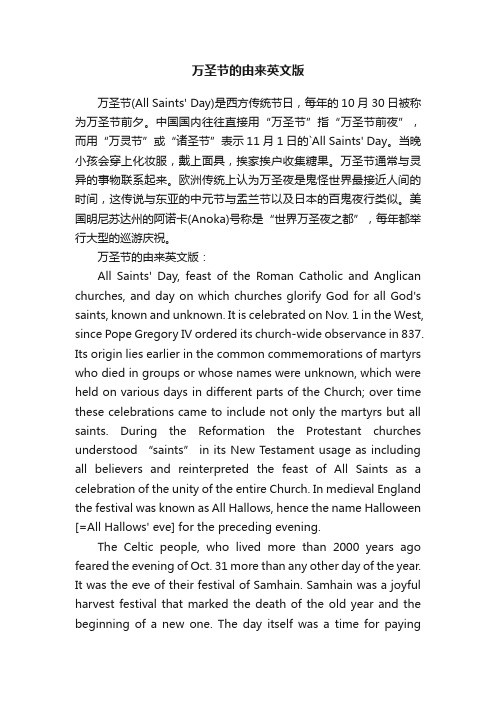
万圣节的由来英文版万圣节(All Saints' Day)是西方传统节日,每年的10月30日被称为万圣节前夕。
中国国内往往直接用“万圣节”指“万圣节前夜”,而用“万灵节”或“诸圣节”表示11月1日的`All Saints' Day。
当晚小孩会穿上化妆服,戴上面具,挨家挨户收集糖果。
万圣节通常与灵异的事物联系起来。
欧洲传统上认为万圣夜是鬼怪世界最接近人间的时间,这传说与东亚的中元节与盂兰节以及日本的百鬼夜行类似。
美国明尼苏达州的阿诺卡(Anoka)号称是“世界万圣夜之都”,每年都举行大型的巡游庆祝。
万圣节的由来英文版:All Saints' Day, feast of the Roman Catholic and Anglican churches, and day on which churches glorify God for all God's saints, known and unknown. It is celebrated on Nov. 1 in the West, since Pope Gregory IV ordered its church-wide observance in 837. Its origin lies earlier in the common commemorations of martyrs who died in groups or whose names were unknown, which were held on various days in different parts of the Church; over time these celebrations came to include not only the martyrs but all saints. During the Reformation the Protestant churches understood “saints” in its New Testament usage as including all believers and reinterpreted the feast of All Saints as a celebration of the unity of the entire Church. In medieval England the festival was known as All Hallows, hence the name Halloween [=All Hallows' eve] for the preceding evening.The Celtic people, who lived more than 2000 years ago feared the evening of Oct. 31 more than any other day of the year. It was the eve of their festival of Samhain. Samhain was a joyful harvest festival that marked the death of the old year and the beginning of a new one. The day itself was a time for payinghomage to the sun god Baal who had provided the people with the ripened grain for use in the upcoming winter. Come evening evil spirits were everywhere. Charms and spells were said to have more power on the eve of Samhain. Several rituals were performed by the Celtic priests, Druids, to appease the Lord of the Dead.Halloween was called Samhain by the Irish. It came to be known as Halloween sometime around the fifth century A.D. .Samhain took place on October 31 through to November 1. During this period, it was believed that the boundaries between our world and the world of the dead were weakened, allowing spirits of the recently dead to cross over and possess the living.To celibrate the festival, the Irish would dress up in bizarre costumes and parade through their villages,causing destruction and saying "Trick-or-Treat", in order to scare off any recently departed souls who might be prowling for bodies to inhabit.This yearly festival was later brought to the other regions of the world, including continental Europe and North America. Irish immigrants brought several customs with them, including one of the symbols most commonly associated with Halloween -- the "Jack Lantern".According to Irish folklore, there once lived a man named Jack who was known for being a drunk and a prankster. One night Jack tricked the devil into climbing a tree, and quickly carved an image of a cross on the trunk, trapping the devil. Jack then made him promise that, in exchange for letting him out of the tree, the Devil would never tempt him to sin again. He reluctantly agreed, but was able to exact his revenge upon Jack's death. Because of his mischievous ways in life, Jack was barred from enteringheaven and because of his earlier trick; he was also barred from hell. So he was doomed to wander the earth until the end of time, with only a "Jack Lanterns" to warm him.In Ireland, they originally used turnips for their "Jack Lanterns", but upon arriving in north America, they discovered that pumpkins were abundant and easier to carve out.。
万圣节的由来英文版简短带中文翻译
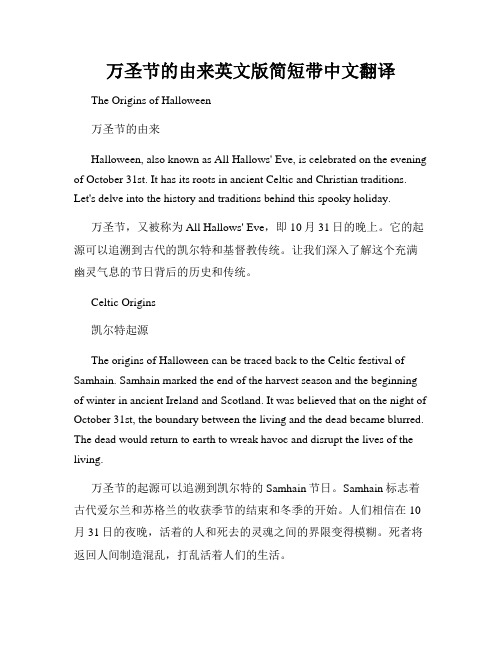
万圣节的由来英文版简短带中文翻译The Origins of Halloween万圣节的由来Halloween, also known as All Hallows' Eve, is celebrated on the evening of October 31st. It has its roots in ancient Celtic and Christian traditions. Let's delve into the history and traditions behind this spooky holiday.万圣节,又被称为All Hallows' Eve,即10月31日的晚上。
它的起源可以追溯到古代的凯尔特和基督教传统。
让我们深入了解这个充满幽灵气息的节日背后的历史和传统。
Celtic Origins凯尔特起源The origins of Halloween can be traced back to the Celtic festival of Samhain. Samhain marked the end of the harvest season and the beginning of winter in ancient Ireland and Scotland. It was believed that on the night of October 31st, the boundary between the living and the dead became blurred. The dead would return to earth to wreak havoc and disrupt the lives of the living.万圣节的起源可以追溯到凯尔特的Samhain节日。
Samhain标志着古代爱尔兰和苏格兰的收获季节的结束和冬季的开始。
万圣节简介中英文
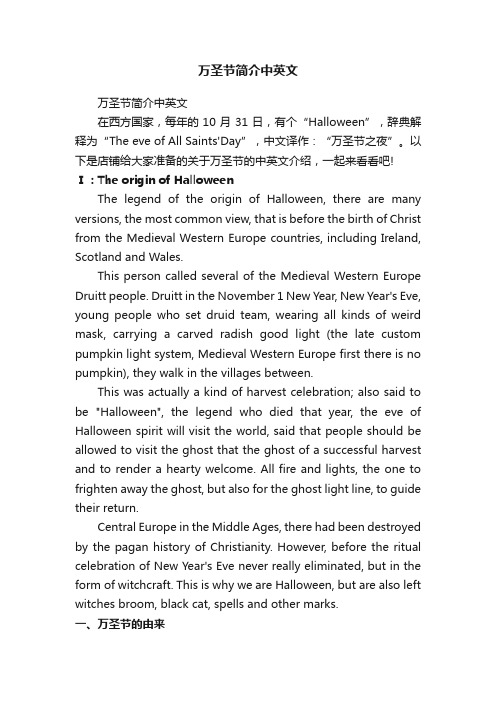
万圣节简介中英文万圣节简介中英文在西方国家,每年的10月31日,有个“Halloween”,辞典解释为“The eve of All Saints'Day”,中文译作:“万圣节之夜”。
以下是店铺给大家准备的关于万圣节的中英文介绍,一起来看看吧! Ⅰ:The origin of HalloweenThe legend of the origin of Halloween, there are many versions, the most common view, that is before the birth of Christ from the Medieval Western Europe countries, including Ireland, Scotland and Wales.This person called several of the Medieval Western Europe Druitt people. Druitt in the November 1 New Year, New Year's Eve, young people who set druid team, wearing all kinds of weird mask, carrying a carved radish good light (the late custom pumpkin light system, Medieval Western Europe first there is no pumpkin), they walk in the villages between.This was actually a kind of harvest celebration; also said to be "Halloween", the legend who died that year, the eve of Halloween spirit will visit the world, said that people should be allowed to visit the ghost that the ghost of a successful harvest and to render a hearty welcome. All fire and lights, the one to frighten away the ghost, but also for the ghost light line, to guide their return.Central Europe in the Middle Ages, there had been destroyed by the pagan history of Christianity. However, before the ritual celebration of New Year's Eve never really eliminated, but in the form of witchcraft. This is why we are Halloween, but are also left witches broom, black cat, spells and other marks.一、万圣节的由来关于万圣节由来的传说有许多版本,最普遍的认为,那是源于基督诞生前的古西欧国家,主要包括爱尔兰、苏格兰和威尔士。
万圣节中英文介绍

万圣节中英文介绍万圣节,这个充满神秘和欢乐的节日,每年的 10 月 31 日都会在世界各地掀起一场独特的狂欢。
对于很多人来说,万圣节是一个可以尽情装扮、搞怪和享受派对的时刻。
万圣节的起源可以追溯到古代凯尔特人的萨温节(Samhain)。
当时的人们认为,在 10 月 31 日这一天,夏天正式结束,冬天开始,同时也是阴阳两界的界限最模糊的时刻,逝者的灵魂会回到人间。
为了驱赶恶灵,他们会点燃篝火,穿上奇异的服装,以保护自己并吓走邪灵。
随着时间的推移,基督教传入欧洲后,11 月 1 日被定为“诸圣节”(All Saints' Day),用来纪念所有的圣徒。
而 10 月 31 日的前夜,也就是我们现在所说的万圣节,逐渐成为了一个融合了各种传统和文化元素的节日。
在英文中,“万圣节”通常被称为“Halloween”。
这个词由“All Hallows' Eve”演变而来,意思是“万圣节前夜”。
在万圣节,装扮是一大特色。
孩子们会穿上各种各样的恐怖或有趣的服装,比如吸血鬼、女巫、鬼魂、僵尸、超级英雄等等。
他们会提着南瓜灯,挨家挨户地敲门,喊着“Trick or treat!”(不给糖就捣蛋!)。
如果主人家给了糖果,孩子们就会开心地离开;如果没有,他们可能就会小小的恶作剧一下。
南瓜灯也是万圣节不可或缺的元素。
通常,人们会把南瓜掏空,雕刻出可怕的面孔,然后在里面放上蜡烛。
夜晚,南瓜灯发出的光芒,为整个节日增添了神秘的氛围。
英文中,南瓜灯被称为“Jacko'lantern”。
除了孩子们的活动,成年人也会举办各种万圣节派对。
派对上,人们会精心装扮自己,场地也会布置得充满恐怖和神秘的气息。
会有各种恐怖的道具、蜘蛛网、蝙蝠等等。
万圣节的美食也很有特色。
有糖果玉米(Candy Corn),这种小小的三角形糖果,颜色鲜艳,非常受孩子们欢迎。
还有用巧克力做成的蝙蝠形状的巧克力、眼球形状的糖果等等。
在一些地区,还会有万圣节游行活动。
万圣节的由来50字英文-万圣节的由来英文简短
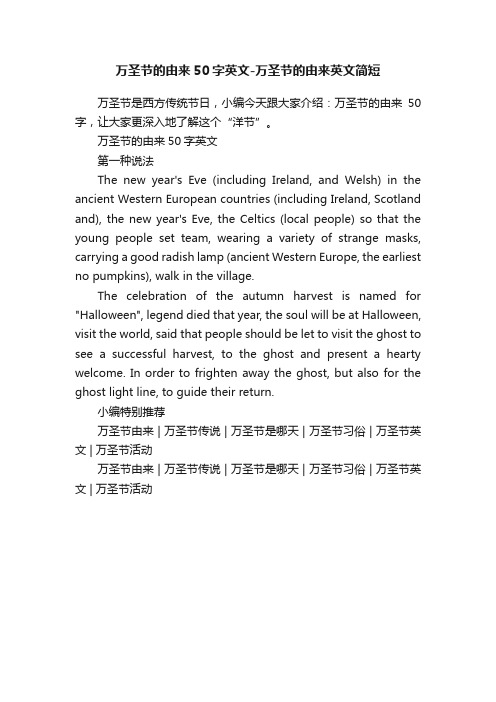
万圣节的由来50字英文-万圣节的由来英文简短万圣节是西方传统节日,小编今天跟大家介绍:万圣节的由来50字,让大家更深入地了解这个“洋节”。
万圣节的由来50字英文第一种说法The new year's Eve (including Ireland, and Welsh) in the ancient Western European countries (including Ireland, Scotland and), the new year's Eve, the Celtics (local people) so that the young people set team, wearing a variety of strange masks, carrying a good radish lamp (ancient Western Europe, the earliest no pumpkins), walk in the village.The celebration of the autumn harvest is named for "Halloween", legend died that year, the soul will be at Halloween, visit the world, said that people should be let to visit the ghost to see a successful harvest, to the ghost and present a hearty welcome. In order to frighten away the ghost, but also for the ghost light line, to guide their return.小编特别推荐万圣节由来 | 万圣节传说 | 万圣节是哪天 | 万圣节习俗 | 万圣节英文 | 万圣节活动万圣节由来 | 万圣节传说 | 万圣节是哪天 | 万圣节习俗 | 万圣节英文 | 万圣节活动。
万圣节的由来英文版50字
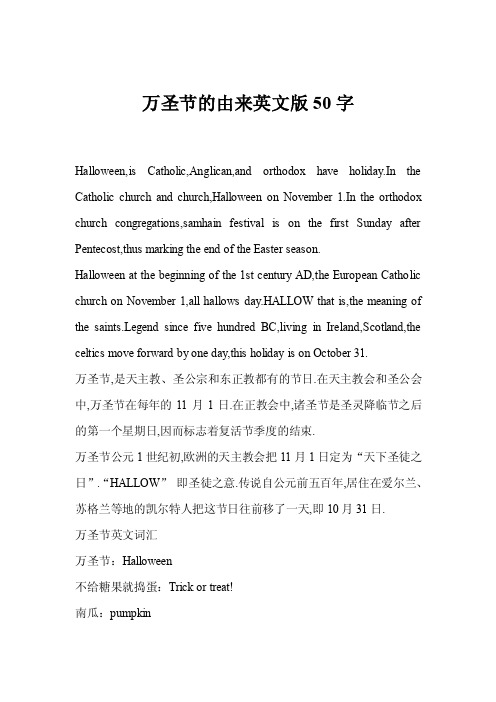
万圣节的由来英文版50字Halloween,is Catholic,Anglican,and orthodox have holiday.In the Catholic church and church,Halloween on November 1.In the orthodox church congregations,samhain festival is on the first Sunday after Pentecost,thus marking the end of the Easter season.Halloween at the beginning of the 1st century AD,the European Catholic church on November 1,all hallows day.HALLOW that is,the meaning of the saints.Legend since five hundred BC,living in Ireland,Scotland,the celtics move forward by one day,this holiday is on October 31.万圣节,是天主教、圣公宗和东正教都有的节日.在天主教会和圣公会中,万圣节在每年的11月1日.在正教会中,诸圣节是圣灵降临节之后的第一个星期日,因而标志着复活节季度的结束.万圣节公元1世纪初,欧洲的天主教会把11月1日定为“天下圣徒之日”.“HALLOW”即圣徒之意.传说自公元前五百年,居住在爱尔兰、苏格兰等地的凯尔特人把这节日往前移了一天,即10月31日.万圣节英文词汇万圣节:Halloween不给糖果就捣蛋:Trick or treat!南瓜:pumpkin糖果:candy吸血鬼:vampire骷髅:skeleton幽灵:apparition死神(拿镰刀的那位):grim reaper 僵尸:zombie木乃伊:mummy狼人:werewolf弗兰肯斯坦:Frankenstein。
- 1、下载文档前请自行甄别文档内容的完整性,平台不提供额外的编辑、内容补充、找答案等附加服务。
- 2、"仅部分预览"的文档,不可在线预览部分如存在完整性等问题,可反馈申请退款(可完整预览的文档不适用该条件!)。
- 3、如文档侵犯您的权益,请联系客服反馈,我们会尽快为您处理(人工客服工作时间:9:00-18:30)。
万圣节的由来50字英文,万圣节的由来英
文简短
今天跟大家介绍:万圣节的由来50字,让大家更深入地了解这个“洋节”。
万圣节的由来50字英文
第一种说法
The new year's Eve (including Ireland, and Welsh) in the ancient Western European countries (including Ireland, Scotland and), the new year's Eve, the Celtics (local people) so that the young people set team, wearing a variety of strange masks, carrying a good radish lamp (ancient Western Europe, the earliest no pumpkins), walk in the village.
The celebration of the autumn harvest is named for "Halloween", legend died that year, the soul will be at Halloween, visit the world, said that people should be let to visit the ghost to see a successful harvest, to the ghost and present a hearty welcome. In order to frighten away the ghost, but also for the ghost light line, to guide their return.
特别推荐
| | | | |
译文:古西欧国家(包括爱尔兰、苏格兰和威尔士)的新年在十一月一日,新年前夜,凯尔特人(当地人)让年轻人集队,戴着各种怪异面具,拎着刻好的萝卜灯(古西欧最早没有南瓜),游走于村落间。
当时是秋收的庆典,即"鬼节",传说当年死去的人,灵魂会在万圣节的前夜造访人世,据说人们应该让造访的鬼魂看到圆满的收成,并对鬼魂呈现出丰盛的款待。
一来为了吓走鬼魂,同时也为鬼魂照亮路线,引导其回归。
第二种说法
Five hundred BC, living in Ireland, Scotland and other places of the Celtic people to move forward this day, that is, October 31st.
It is believed that the spirits of the enemy in the day returned to the former residence of find creatures, take this regeneration, and this is man can obtain the regeneration the only hope in after death. And the living fears the dead soul to seize lives, so people will extinguish the fire, candlelight in the day, so that the soul can not find the living dead, and the himself dressed as ghosts and goblins to scare away the dead souls.
特别推荐
| | | | |
After that, they will be the fire of the candle lit again, starting a new year of life.
译文:公元前五百年,居住在爱尔兰、苏格兰等地的凯尔特人把这节日往前移了一天,即10月31日。
人们相信,故人的亡魂会在这一天回到故居找寻生灵,借此再生,而且这是人在死后能获得再生的唯一希望。
而活着的人则惧怕死魂来夺生,于是人们就在这一天熄掉炉火、烛光,让死魂无法找寻活人,又把自己打扮成妖魔鬼怪把死人之魂灵吓走。
之后,他们又会把火种烛光重新燃起,开始新的一年的生活。
第三种说法
The Celtics were very afraid of the night of October 31st,
because they felt that this night, there was a pile of evil spirits lurking in any place. They at home fire to let those evil spirit leave their homes, they believe that the sun god calls the deceased person. They believed that the sun god dead variable for other things, like a cat.
特别推荐
| | | | |
/2015/0921/20150921100024955.png" width="450" alt="万圣节南瓜图片" />
特别推荐
| | | | |
延伸阅读:万圣节英文祝福语
1.You never know what might happen on Halloween. Wait until dark for some spooky surprises. The creatures of the night are waiting. To my dear pal, have a howling Halloween!
2.Trick or treat what it will be? Wishing you a happy Halloween!
3.My Halloween's happy when I freak out with you! Happy Halloween to you my friend!
4.It’s hell lot of fun when I'm with you! Happy Halloween to you!
5.Hope your Halloween is masked with spooky fun just as mine.
6.Thank you for your very special wish. Happy Halloween!
7.Thank you for making my Halloween so special.
8.Thank you for making my cauldrons full of fun! Happy Halloween!
9.Your smile lights up our world! Wishing you a Halloween bright and glowing as you are!
特别推荐
| | | | |
10.It’s Halloween time to dress up in your spookiest best and grab all the fun! Hope it‘s lit up with smiles for you! Happy Halloween!
11. Trick or treat what it will be? Wishing you a happy Halloween!
12. Thank you for your very special wish. Happy Halloween!
13. Thank you for making my Halloween so special.
14. Thank you for making my cauldrons full of fun! Happy Halloween!
15. Your smile lights up our world! Wishing you a Halloween bright and glowing as you are!
16. My Halloween's happy when I freak out with you! Happy Halloween to you ...my friend!
17. It's hell lot of fun when I'm with you! Happy Halloween to you!
18. Hope your Halloween is masked with spooky fun ... just as mine.
19.Thank you for your very special wish. Happy Halloween!
特别推荐
| | | | |
/2016/1025/20161025095835285.jpg" alt="万圣节英文" />
【万圣节英文】11月1日万圣节英文:Hallowmas,南瓜是万圣节的代表。
10月31日是万圣夜英文:Halloween,华语地区常将万圣夜称为万圣节。
万圣节的英文介绍Hallow
2016-10-25。
